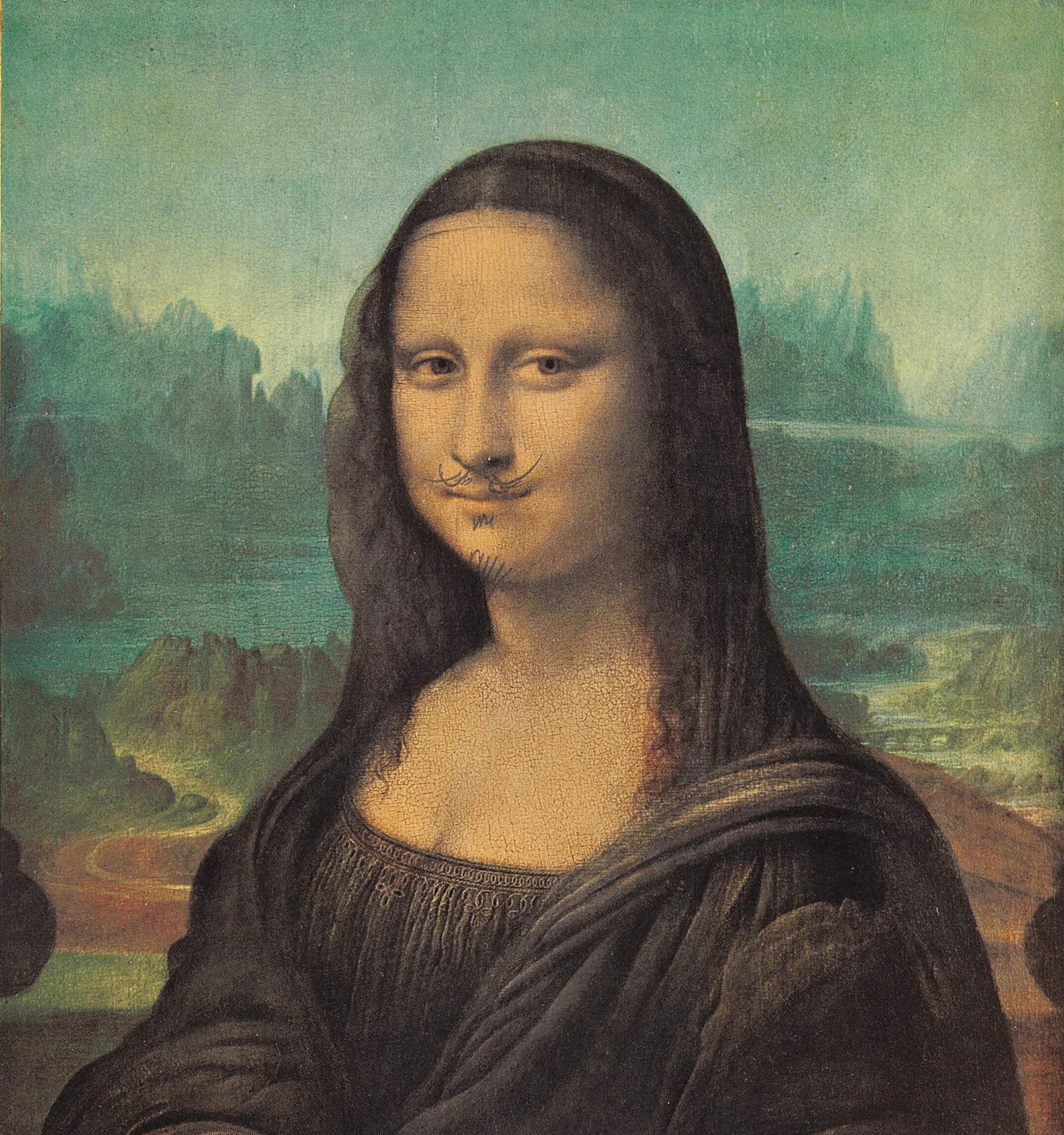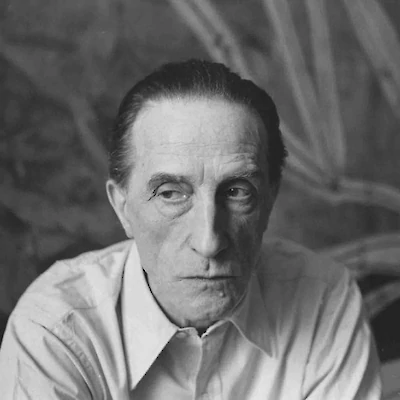

Marcel Duchamp
Giving art a cheerful middle finger
1887 – 1968The great trouble with art in this country at present, and apparently in France also, is that there is no spirit of revolt—no new ideas appearing among the younger artists. They are following along the paths beaten out by their predecessors, trying to do better what their predecessors have already done. In art there is no such thing as perfection. And a creative lull occurs always when artists of a period are satisfied to pick up a predecessor’s work where he dropped it and attempt to continue what he was doing. When on the other hand you pick up something from an earlier period and adapt it to your own work an approach can be creative. The result is not new; but it is new insomuch as it is a different approach.
Art is produced by a succession of individuals expressing themselves; it is not a question of progress. Progress is merely an enormous pretension on our part. There was no progress for example in Corot over Phidias. And “abstract” or “naturalistic” is merely a fashionable form of talking—today. It is no problem: an abstract painting may not look at all “abstract” in 50 years.
During the other war life among the artists in New York was quite different—much more congenial than it has been during these last few years. Among the artists there was much more cohesion—much closer fellowship, much less opportunism. The whole spirit was much different. There was quite a bit of activity, but it was limited to a relatively small group and nothing was done very publicly. Publicity always takes something away. And the great advantage in that earlier period was that the art of the time was laboratory work; now it is diluted for public consumption.
The basis of my own work during the years just before coming to America in 1915 was a desire to break up forms—to “decompose” them much along the lines the cubists had done. But I wanted to go further—much further—in fact in quite another direction altogether. This was what resulted in Nude Descending a Staircase, and eventually led to my large glass, The Bride Stripped Bare by Her Bachelors, Even.
The idea of the Nude came from a drawing which I had made in 1911 to illustrate Jules Laforgue’s poem Encore a cet astre. I had planned a series of illustrations of Laforgue’s poems but I only completed three of them. Rimbaud and Lautreamont seemed too old to me at the time. I wanted something younger. Mallarme and Laforgue were closer to my taste—Laforgue’s Hamlet, particularly. But perhaps I was less attracted by Laforgue’s poetry than by his titles. Cornice agricole, when written by Laforgue, becomes poetry. “Le soir, le piano"—no one else could have written this in his time.
In the drawing Encore a cet astre the figure is, of course, mounting the stairs. But while working on it, the idea of the Nude, or the title—I do not recall which—first came to my mind. I eventually gave the sketch to F. C. Torrey of San Francisco who bought the Nude Descending a Staircase from the 1913 New York Armory Show.
No, I do not feel there was any connection between the Nude Descending a Staircase and futurism. The futurists held their exhibition at the Galerie Bernheim Jeune in January 1912. I was painting the Nude at the same time. The oil sketch for it, however, had already been done in 1911. It is true I knew Severini. But I was working quite by myself at the time—or rather with my brothers. And I was not a café frequenter. Chrono-photography was at the time in vogue. Studies of horses in movement and of fencers in different positions as in Muybridge’s albums were well known to me. But my interest in painting the Nude was closer to the cubists’ interest in decomposing forms than to the futurists’ interest in suggesting movement, or even to Delaunay’s Simultaneist suggestions of it. My aim was a static representation of movement—a static composition of indications of various positions taken by a form in movement-with no attempt to give cinema effects through painting.
The reduction of a head in movement to a bare line seemed to me defensible. A form passing through space would traverse a line; and as the form moved the line it traversed would be replaced by another line —and another and another. Therefore I felt justified in reducing a figure in movement to a line rather than to a skeleton. Reduce, reduce, reduce was my thought; —but at the same time my aim was turning inward, rather than toward externals. And later, following this view, I came to feel an artist might use anything—a dot, a line, the most conventional or unconventional symbol—to say what he wanted to say. The Nude, in this way, was a direct step to the large glass, The Bride Stripped Bare by Her Bachelors, Even. And in the King and Queen painted shortly after the Nude there are no human forms or indications of anatomy. But in it one can see where the forms are placed; and for all this reduction I would never call it an “abstract” painting . . .
Futurism was an impressionism of the mechanical world. It was strictly a continuation of the Impressionist Movement. I was not interested in that. I wanted to get away from the physical aspect of painting. I was much more interested in recreating ideas in painting. for me the title was very important. I was interested in making painting serve my purpose, and in getting away from the physicality of painting. For me Courbet had introduced the physical emphasis in the XIXth century. I was interested in ideas—not merely in visual products. I wanted to put painting once again at the service of the mind. And my painting was, of Course, at once regarded as “intellectual,” “literary” painting. It was true I was endeavoring to establish myself as far as possible from “pleasing” and “attractive” physical paintings. That extreme was seen as literary. My King and Queen was a chess king and queen.
In fact until the last hundred years all painting had been literary or religious: it had all been at the service of the mind. This characteristic was lost little by little during the last century. The more sensual appeal a painting provided—the more animal it became—the more highly it was regarded. It was a good thing to have had Matisse’s work for the beauty it provided. Still it created a new wave of physical painting in this century or at least fostered the tradition we inherited from the XIXth century masters.
Dada was an extreme protest against the physical side of painting. It was a metaphysical attitude. It was intimately and consciously involved with “literature.” It was a sort of nihilism to which I am still very sympathetic. It was a way to get out of a state of mind—to avoid being influenced by one’s immediate environment, or by the past: to get away from clichés—to get free. The “blank” force of Dada was very salutary. It told you “don't forget you are not quite so blank as you think you are!” Usually a painter confesses he has his landmarks. He goes from landmark to landmark. Actually he is a slave to landmarks—even to con-temporary ones.
Dada was very serviceable as a purgative. And I think I was thoroughly conscious of this at the time and of a desire to effect a purgation in myself. I recall certain conversations with Picabia along these lines. He had more intelligence than most of our contemporaries. The rest was either for or against Cezanne. There was no thought of anything beyond the physical side of painting. No notion of freedom was taught. No philosophical outlook was introduced. The cubists, of course, were inventing a lot at the time. They had enough on their hands at the time not to be worried about a philosophical outlook; and cubism gave me many ideas for decomposing forms. But I thought of art on a broader scale. There were discussions at the time of the fourth dimension and of non-Euclidean geometry. But most views of it were amateurish. Metzinger was particularly attracted. And for all our misunderstandings through these new ideas we were helped to get away from the conventional way of speaking—from our café and studio platitudes.
Brisset and Roussel were the two men in those years whom I admired for their delirium of imagination. Jean-Pierre Brisset was discovered by Jules Romains through a book he picked up from a stall on the quais. Brisset’s work was a philological analysis of language—an analysis worked out by an incredible network of puns. He was a sort of a Douanier Rousseau of philology. Romains introduced him to his friends. And they, like Apollinaire and his companions, held a formal celebration to honor him in front of Rodin’s Thinker in front of the Pantheon where he was hailed as Prince of Thinkers.
But Brisset was one of the real people who has lived and will be forgotten. Roussel was another great enthusiasm of mine in the early days. The reason I admired him was because he produced something I had never seen. That is the only thing that brings admiration from my inner-most being—something completely independent—nothing to do with the great names or influences. Apollinaire first showed Roussel’s work to me. It was poetry. Roussel thought he was a philologist, a philosopher and metaphysician. But he remains a great poet.
It was fundamentally Roussel who was responsible for my glass, The Bride Stripped Bare by Her Bachelors, Even. From his Impressions d'Afrique I got the general approach. This play of his which I saw with Apollinaire helped me greatly on one side of my expression. I saw at once I could use Roussel as an influence. I felt that as a painter it was much better to be influenced by a writer than by another painter. And Roussel showed me the way.
My ideal library would have contained all Roussel’s writings—Brisset, perhaps Lautreamont and Mallarme. Mallarme was a great figure. This is the direction in which art should turn: to an intellectual expression, rather than to an animal expression. I am sick of the expression “bate comme un peintre“— “stupid as a painter.”
From an interview with James Johnson Sweeney, The Bulletin of the Museum of Modern Art, Vol. XIII, no. 4-5,1946, pp. 19-21.